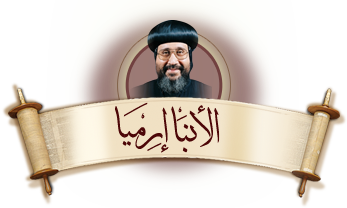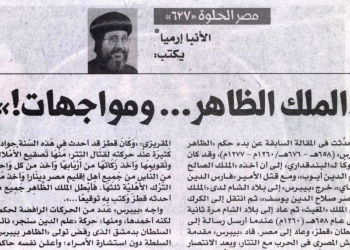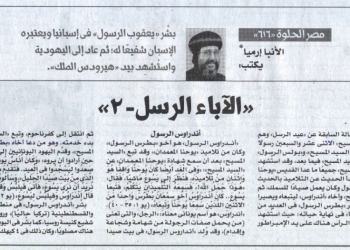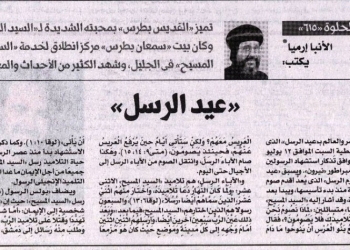A previous article talked about Pope Mikhail III, the seventy-first patriarch of Alexandria, and about the prophecy of one of the monks that Pope Mikhail would be ordained as a patriarch, he ordained a number of bishops, and finally passed away after spending a very short period; few months only, on the See of Saint Mark. He was succeeded by PopeYouhanna V, the seventy-second patriarch of Alexandria, following many negotiations and discussions thatwere held and resulted in holding a council attended by the priests and senior chiefs ofAlexandria. The council ended with them unanimously choosing him. He had been a monk named YouannesibnAbiAl-Fath. It is worthy mention that in this council, he was asked to give his opinion on another monk whose name wasYouannesibnKadran- who had beenseeking and longing for the Patriarchate – and whether he was worthy for the position of the Patriarchate or not, so he replied: “Yes, he is better than me and knows the laws more” ; His answer sounded good in the eyes of the attendees, and his status was elevated among all of them for his wise words. Afterwards, he was ordained a patriarch, with the name YouhannaV, on the chair of Saint Mark the Apostle during the days of Caliph Al-Hafiz Li-Din Allah. Pope YouhannaV wanted to ordain YouannesibnKadranas the bishop of Samanoud in order to comfort him as compensation, but he refused and continued his life moving between the monastery and the countryside until his death.
Pope YouhannaV was a contemporary of the incident of Minister Radwan bin Walakhshiwho escaped and mobilized a number of soldiers, then he entered into Cairo and his death at the hands of the Sudanese soldiers and those who were with them. Caliph Al-Hafiz remained without a minister until he died in 544 AH (1149 AD). Abu Al-Mansour succeeded Al-Hafiz in caliphate and was nicknamed Al-Zafir (The victorious). He appointed Al-Adel bin Al-Salar as a minister; during his ministry period, the Copts suffered greatly. Historian Ava Severus ibn Al-Muqaffaamentioned: “During the days of Al-Adel bin Al-Salar, the Copts were commanded to tighten the girdle (a belt on the waist) and take off theirpalliums (a kind of scarves). But this lasted for three days only.” The reason behind this was a slander raised to the governor of Egypt that such actions would bring in a lot of money, so when it brought no money at all, it was called on the fourth day that the Copts would get back to their habits.
The era of Pope Youhanna V also witnessed the fall of Ashkelon, the last of the Fatimid cities in the Levant, in the hands of the Franks in 1153. In 1154, the incident of killing Caliph Al-Zafirat the hands of Nasir al-Din Ibn Abbas the minister took place. Then Minister Abbas killed the two brothers of the Caliph, accusing them of killing the caliph. He also appointed the caliph’s little child as a caliph and called him Al-Faez Bi Din Allah. Afterwards, Talae’ ibnRuzayk, the governor of Al-Bahnasa, sought to take revenge for the caliph’s murder from Minister Abbas and his son, so they fled, but he finally managed to kill Abbas and capture his son (as mentioned in previous articles).
When Talae’ibnRuzayk managed to assume the ministry, it was mentioned about him: “He loved to collect money, and he killed many in crave for money, and he collected a lot from illegal sources. He used to draw fortunetellers closer to him and listen carefully to their advices; he hated Christians and some Islamic ideologies as he belonged to the Shiite doctrine…” Prices got high in those days, and the cattle plague appeared in Egypt for the first time, killing numbers of cows. Caliph al-Faez died in 1160, and the son of Al-Hafiz assumed caliphate after him, and was called Caliph Al-Adid Li-Din Allah. During his caliphate, Talae’ the Minister was killed, and his son Ruzayk assumed the ministry succeeding his father. But the governor of Upper Egypt, Shawar bin Mujir al-Saadihad seized the ministry, before Durgham bin Amer attacked him. Shawar fled to Damascus and asked for the help of King Al-AdelNur al-Din, who sent his soldiers under the leadership of Shirkuh and his nephew Salah al-Din. They restored Shawar to his position after ferocious wars which all the Egyptians were involved in and suffered from, especially the Copts who were exposed to several offenses; they were being sold as slaves and some of them were even martyred, such as the monk called Shennoufa from the Monastery of SaintMacarius located in Wadi al-Natron, and many churches were demolished. And … stories about beautiful Egypt never end!
The General Bishop
Head of the Coptic Orthodox Cultural Center


 العربية
العربية











